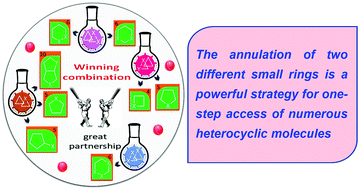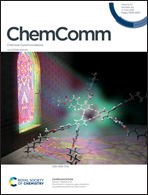Relieving the stress together: annulation of two different strained rings towards the formation of biologically significant heterocyclic scaffolds
Abstract
Small carbo- and heterocycles have become versatile building blocks owing to their intrinsic ring strain and ease of synthesis. However, the traditional approaches of heterocycle synthesis involved the combination of one strained-carbocycle or heterocycle with one unsaturated molecule. On the contrary, there is an exciting possibility of combining two different strained rings to furnish varieties of heterocycles, where one of the strained rings can act as a valuable alternative to the unsaturated molecule. These strategies are also useful to access multi-functionalized rings. Despite these distinctive synthetic benefits, this chemistry has not drawn considerable attention of the community. In this minireview, we explicitly choose this topic to reveal the unexplored possibilities with these different strained rings. This minireview provides comprehensive details with the mechanistic rationale about the reactivity of these pairs of small rings when they are allowed to react together in the presence of different Lewis acids. Subsequently, it will also open a new avenue for heterocycle synthesis.



 Please wait while we load your content...
Please wait while we load your content...